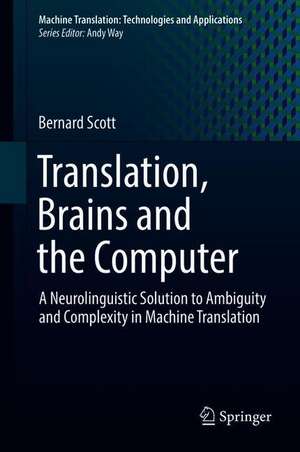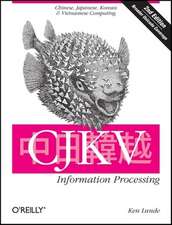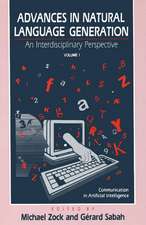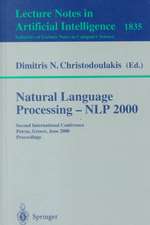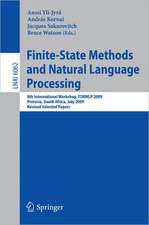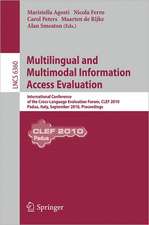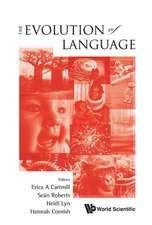Translation, Brains and the Computer: A Neurolinguistic Solution to Ambiguity and Complexity in Machine Translation: Machine Translation: Technologies and Applications, cartea 2
Autor Bernard Scotten Limba Engleză Hardback – 15 iun 2018
| Toate formatele și edițiile | Preț | Express |
|---|---|---|
| Paperback (1) | 928.25 lei 6-8 săpt. | |
| Springer International Publishing – 28 dec 2018 | 928.25 lei 6-8 săpt. | |
| Hardback (1) | 934.55 lei 6-8 săpt. | |
| Springer International Publishing – 15 iun 2018 | 934.55 lei 6-8 săpt. |
Preț: 934.55 lei
Preț vechi: 1168.19 lei
-20% Nou
Puncte Express: 1402
Preț estimativ în valută:
178.83€ • 191.23$ • 149.10£
178.83€ • 191.23$ • 149.10£
Carte tipărită la comandă
Livrare economică 18 aprilie-02 mai
Preluare comenzi: 021 569.72.76
Specificații
ISBN-13: 9783319766287
ISBN-10: 3319766287
Pagini: 170
Ilustrații: XVI, 241 p. 55 illus.
Dimensiuni: 155 x 235 mm
Greutate: 0.54 kg
Ediția:1st ed. 2018
Editura: Springer International Publishing
Colecția Springer
Seria Machine Translation: Technologies and Applications
Locul publicării:Cham, Switzerland
ISBN-10: 3319766287
Pagini: 170
Ilustrații: XVI, 241 p. 55 illus.
Dimensiuni: 155 x 235 mm
Greutate: 0.54 kg
Ediția:1st ed. 2018
Editura: Springer International Publishing
Colecția Springer
Seria Machine Translation: Technologies and Applications
Locul publicării:Cham, Switzerland
Cuprins
1 Introduction.- 2 Background.- Logos Model Beginnings.- Advent of Statistical MT.- Overview of Logos Model Translation Process.- Psycholinguistic and Neurolinguistic Assumptions.- On Language and Grammar.- Conclusion.- 3 – Language and Ambiguity: Psycholinguistic Perspectives.- Levels of Ambiguity.- Language Acquisition and Translation.- Psycholinguistic Bases of Language Skills.- Practical Implications for Machine Translation.- Psycholinguistics in a Machine.- Conclusion.- 4– Language and Complexity: Neurolinguistic Perspectives .- Cognitive Complexity.- A Role for Semantic Abstraction.- Connectionism and Brain Simulation.- Logos Model as a Neural Network.- Language Processing in the Brain.- MT Performance and Underlying Competence.- Conclusion.- 5 – Syntax and Semantics: Dichotomy or Integration? .- Syntax versus Semantics: Is There a Third, Semantico- Syntactic Perspective?.- Recent Views of the Cerebral Process.- Syntax and Semantics: How Do They Relate?.- Conclusion.- 6 –Logos Model: Design and Performance.- The Translation Problem.- How Do You Represent Natural Language?.- How Do You Store Linguistic Knowledge?.- How Do You Apply Stored Knowledge To The Input Stream?.- How do you Effect Target Transfer and Generation?.- How Do You Deal with Complexity Issues?.- Conclusion.- 7 – Some limits on Translation Quality.- First Example.- Second Example.- Other Translation Examples.- Balancing the Picture.- Conclusion.- 8 – Deep Learning MT and Logos Model.- Points of Similarity and Differences.- Deep Learning, Logos Model and the Brain.- On Learning.- The Hippocampus Again.- Conclusion.- Part II.- The SAL Representation Language.- SAL Nouns.- SAL Verbs.- SAL Adjectives.- SAL Adverbs.
Recenzii
“Natural language processing is one of the most rapidly evolving areas of artificial intelligence, and is the subject of this excellent book. … One of the important contributions of this valuable resource is its presentation and comparison of many current state-of-the-art machine translation systems available to the general public. Summing Up: Recommended. Advanced undergraduates through faculty and professionals.” (J. Brzezinski, Choice, Vol. 56 (6), February, 2019)
Textul de pe ultima copertă
This book is about machine translation (MT) and the classic problems associated with this language technology. It examines the causes of these problems and, for linguistic, rule-based systems, attributes the cause to language’s ambiguity and complexity and their interplay in logic-driven processes. For non-linguistic, data-driven systems, the book attributes translation shortcomings to the very lack of linguistics. It then proposes a demonstrable way to relieve these drawbacks in the shape of a working translation model (Logos Model) that has taken its inspiration from key assumptions about psycholinguistic and neurolinguistic function. The book suggests that this brain-based mechanism is effective precisely because it bridges both linguistically driven and data-driven methodologies. It shows how simulation of this cerebral mechanism has freed this one MT model from the all-important, classic problem of complexity when coping with the ambiguities of language. Logos Model accomplishes this by a data-driven process that does not sacrifice linguistic knowledge, but that, like the brain, integrates linguistics within a data-driven process. As a consequence, the book suggests that the brain-like mechanism embedded in this model has the potential to contribute to further advances in machine translation in all its technological instantiations.
Caracteristici
Addresses fundamental issues to solve the classic problems with machine translation Recounts the little known background of early events affecting the history of machine translation Identifies complexity as principal reason why machine translation has had limited success Illustrates problems of ambiguity and complexity in various present-day machine translation models, rule-based (RBMT), statistical (SMT) and neural MT (NMT)
